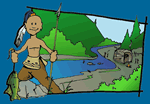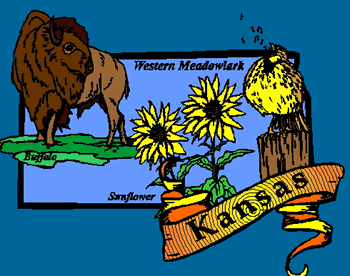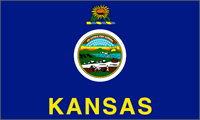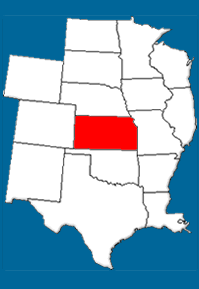


Geography and Landforms:
Kansas is bordered by Nebraska on the north and Oklahoma on the south. To the east is Missouri and to the west is Colorado. It is the 15th largest of the 50 states.
|
 History:
Spanish explorer Francisco de Coronado is believed to have been the first European to explore what is now Kansas in 1541.
|
 Economy:
Historically, Kansas has had an agricultural economy. Today, manufacturing and services produce more income, but farming is still important, and Kansas ranks third in the U.S. in the number of acres devoted to agriculture. Kansas leads the country in its production of wheat, and is also an important producer of grain sorghum, corn, hay, soybeans, and sunflowers. However, Kansans started raising cattle in the 1880s and cattle and calves represent its most valuable agricultural product. The Kansas City stockyards are among the largest in the U.S., and food processing is the state's third largest industry.
|
 First Inhabitants:
Archaeologists tell us that people have been living in the area now known as Kansas since 12,000 BC, during the end of the Ice Age. Huge animals such as mammoth and mastodon lived in the area until climate change made it too warm for them to survive. It is believed that the first people who migrated to Kansas were descendents of people from Asia who crossed into North America through Alaska. These people were known as Paleo-Indians and were nomadic hunter-gatherers. These people hunted the mammoth and mastodon as well as eating berries, seeds, roots, and other small animals. They used spears tipped with stone points for hunting.
|
Books Related To Kansas100 Cupboards - N.D. Wilson Cabin in the Snow - Deborah Hopkinson Caleb's Story - Patricia MacLachlan Moon over Manifest - Clare Vanderpool Out of Patience - Brian Meehl Riddle of the Prairie Bride - Kathryn Reiss S is for Sunflower: A Kansas Alphabet - Devin Scillian The Van Gogh Caf? - Cynthia Rylant Wagon Wheels - Barbara Brenner |
Famous Citizens:
|
| Capital: | Topeka |
| Entered Union: | January 29, 1861 |
| Population: | 2,904,021 |
| Area | 82,277 |
| Bird | Western Meadowlark |
| Flower | Sunflower |
| Nickname: | Sunflower State |
| Governor | Sam Brownback |
Places to Visit in Kansas: (Click the links to learn more.)
|



